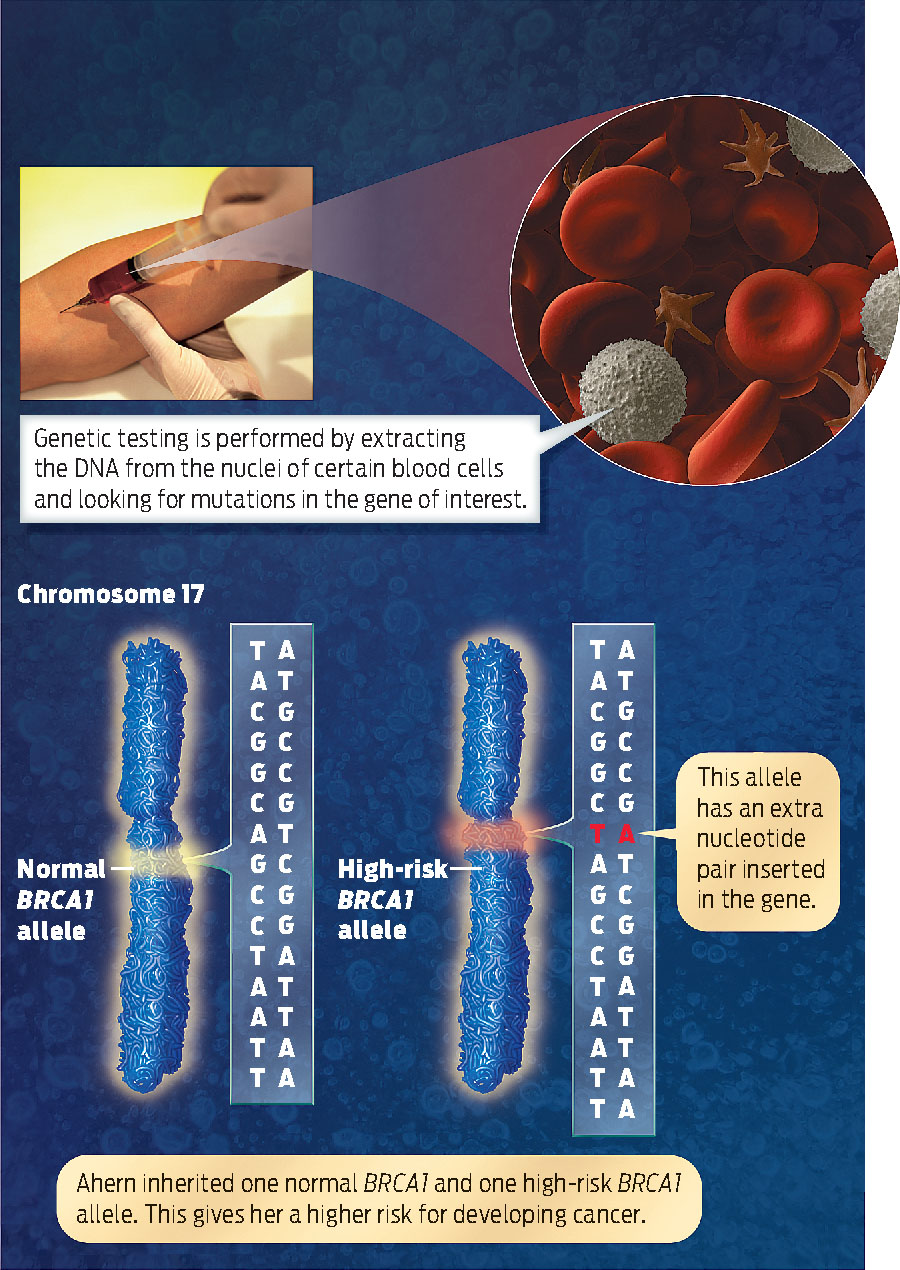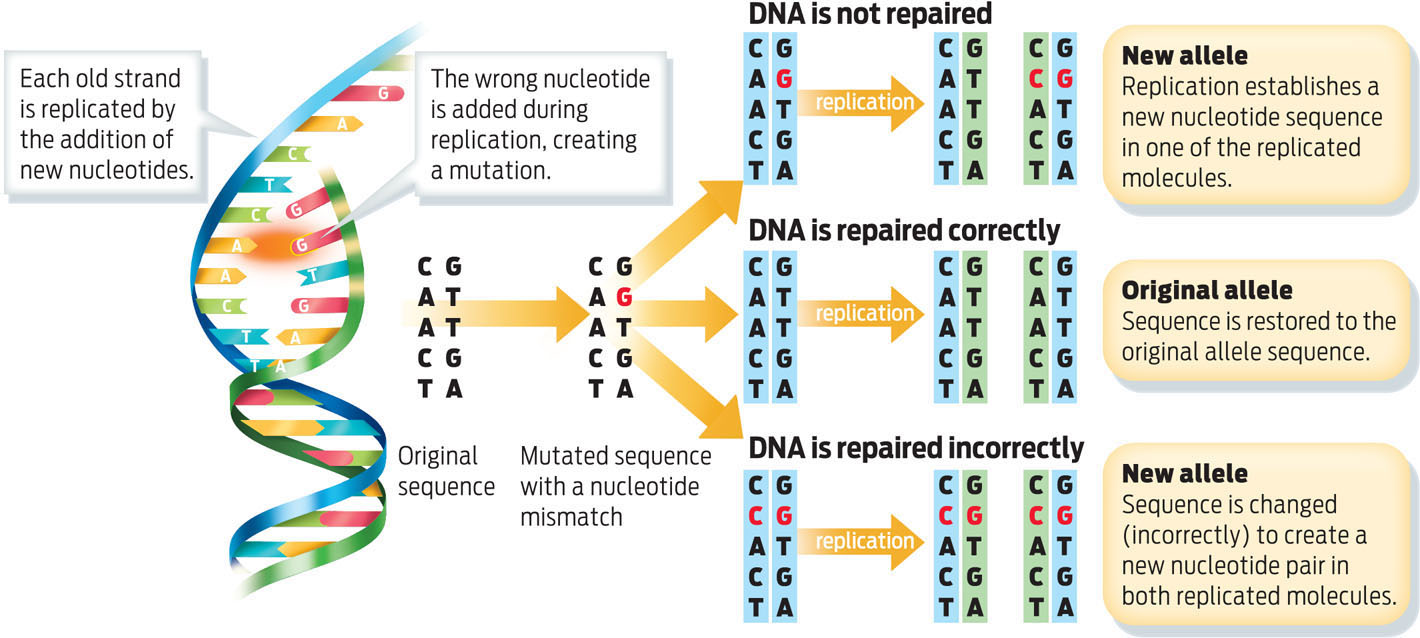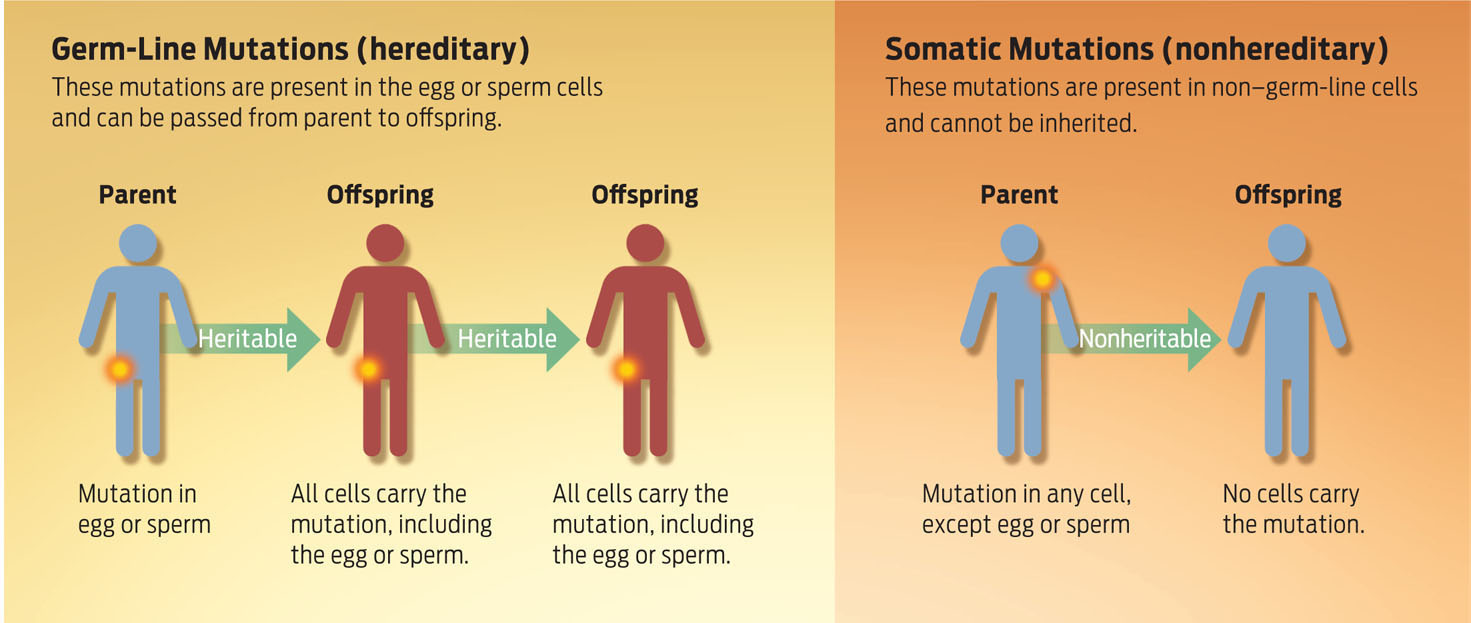“HEREDITARY CANCER”
MUTATION A change in the nucleotide sequence of DNA.
Cancer is a disease of uncontrolled cell division (see Chapter 9). It results from mutations in DNA. The mutations affect the structure and function of proteins that are important for the normal functioning of the cell cycle. Often, these mutations occur in the cells of the tissue where the cancer develops–for example, the skin. Because these skin cell mutations are not passed from parent to child, neither is the skin cancer; just because your parent got skin cancer from spending too much time in the sun doesn’t mean you will also pay the price.
215
Women who, like Ahern, have a genetic predisposition to getting cancer are often said to have “hereditary” or “inherited” cancer. This does not mean that their cancer was passed from parent to child. It means that they have inherited a mutation, from one or both parents, that makes the development of cancer much more likely. In other words, the cancer itself is not inherited, but the risk of getting it is.
In Ahern’s case, an inherited mutation in one of the copies of her BRCA1 gene predisposed her to cancer. The mutation causes the BRCA1 gene to make a dysfunctional BRCA1 protein, which in its normal form helps to regulate the cell cycle so that a cell can repair DNA damage. One mutated gene, inherited from one parent, is enough to significantly increase the risk of getting cancer.
People born with certain mutations in the gene BRCA1 have a higher risk of developing cancer than people with two normal BRCA1 alleles. A genetic test can ascertain whether a person carries any of the BRCA1 high-risk alleles.

Recall from Chapter 8 that alternative versions of the same gene are called alleles. How does a mutated gene differ from an allele? In fact, they are essentially the same thing: an allele is a mutated version of a gene, and scientists often use the terms interchangeably. Ahern’s mutation is just one of more than 600 mutations found in the BRCA1 gene. Another way of saying this is that there are more than 600 alleles of the BRCA1 gene in the population. Each allele has a different nucleotide sequence. These different alleles arose because mutations resulted in the substitution, deletion, or insertion of one or more nucleotides within the gene. Some of these alleles put women at high risk for developing cancer (INFOGRAPHIC 10.1).
To understand how there can be so many versions of a single gene in a population, remember that every time a cell replicates its DNA, mistakes can occur. About once every 10,000 to 100,000 times, DNA polymerase, the enzyme responsible for adding nucleotides to a new strand of DNA, will add the wrong nucleotide, adding for instance a guanine (G) instead of a thymine (T) to pair with an adenine (A), or adding too many or too few bases in a specific location. Similarly, a variety of chemicals–both in the environment and naturally produced in the body–can alter the base composition.
216
Most of the time, these mistakes in the nucleotide order are repaired by a cell’s error correction machinery. Groups of enzymes “proofread” the nucleotides added to the new DNA strand. If a newly added nucleotide is not complementary to its partner on the template strand–if a G is incorrectly paired with an A, for example—these enzymes replace that nucleotide with the correct one. DNA damage is usually repaired at cell cycle checkpoints (see Chapter 9), points in the cycle at which the cell is monitored for such mistakes, and where, if necessary, the cell’s progress through the cycle is delayed until DNA repair has taken place. If the damage is irreparable, the cell self-destructs through apoptosis. On average, less than one mistake in 10 billion nucleotides makes it through this system of checkpoints. But think how often a given gene is replicated in a population and you can see how over time a rate of 1 in 10 billion can produce quite a number of mutations. This is how new alleles are introduced into the population (INFOGRAPHIC 10.2).
DNA replication errors and other alterations can lead to permanent mutations if they are not repaired or are repaired incorrectly.

Not all mutations that arise in cells are passed on to offspring. Mutations are inherited by offspring only if they occur in sperm or egg cells during meiosis. That’s because sperm and egg cells are the only parent cells that go into making an embryo.
GERM-LINE MUTATION A mutation occurring in gametes; passed on to offspring.
Some of these mutations are so detrimental that they aren’t compatible with life, and the embryo spontaneously aborts. Others aren’t severe enough to harm a fetus or prevent birth, but they impair health after birth-as with diseases like cystic fibrosis and Huntington disease. Some mutations are neutral in their effects: they may change a nucleotide here and there, but don’t seriously affect health. And some mutations are actually beneficial: a mutation that enables the blood to carry more oxygen, for example, might be an advantage to someone who lives in high altitudes (see Chapter 28).

Mutations we inherit from our parents are present in all the cells of our body. Moreover, these mutations are faithfully copied every time our cells divide. Such inherited mutations are also called germ-line mutations because the gene changes are found in the sperm and egg cells–the germ cells–and can be passed from parent to child each generation.
SOMATIC MUTATION A mutation that occurs in a body (nongamete) cell; not passed on to offspring.
217
By contrast, somatic mutations–those that occur in cells in the rest of the body–are not passed on to future generations, although they can cause disease in the affected individual. A person who acquires a mutation in a skin cell from too much sun exposure, for example, will not pass this mutation on to his or her children. That’s because the mutation did not occur in sperm or egg cells, nor will it affect those cells. This mutation can, however, be passed by mitotic cell division to daughter cells of the mutated cell and cause disease in the affected person. In the case of mutations caused by UV exposure, for example, some of these may occur in skin cells and lead to the development of skin cancer. This is one way nonhereditary (or “sporadic”) cancers develop (INFOGRAPHIC 10.3).
Mutations that occur in sperm or egg cells are germ-line mutations that can be passed on to offspring. These inherited mutations are then found in every cell of the offspring, including egg or sperm cells, and can be passed on to subsequent generations. Somatic mutations are those that occur in any cell in the body other than the sperm or egg. These mutations are not inherited but may cause disease in the individual that acquires them.

Now imagine germ-line mutations accumulating over thousands of years in a population. As long as a mutation does not affect the ability to reproduce, it will be passed on to future generations through sexual reproduction. The result is that a single gene such as BRCA1 can have hundreds of different nucleotide sequences, or alleles, in a population.
218